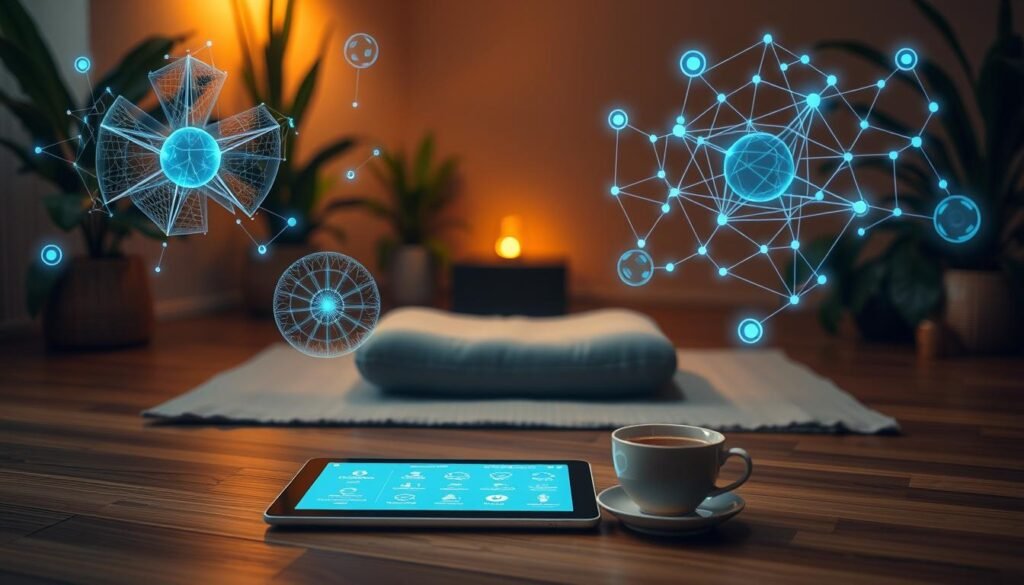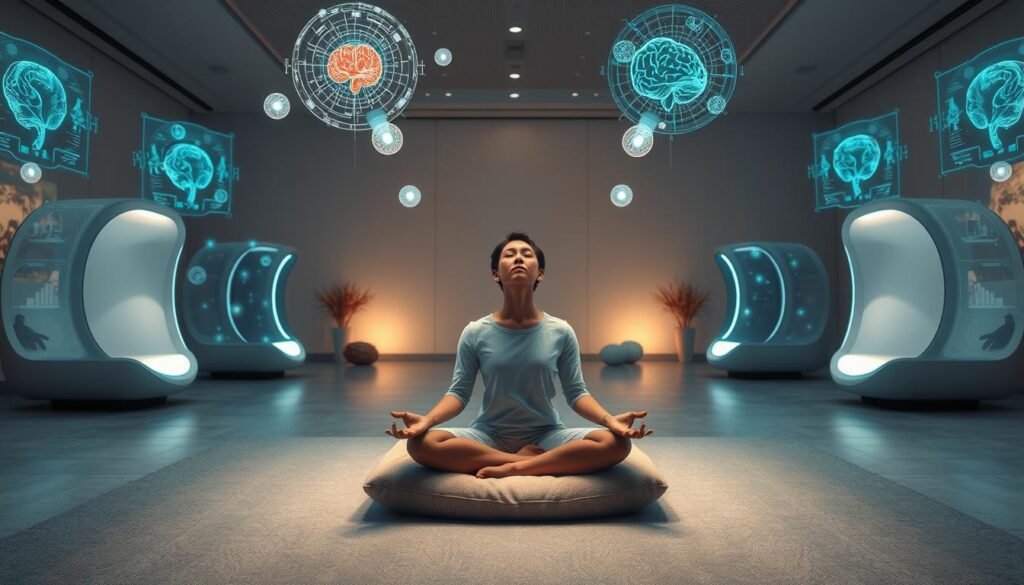How AI and Mindfulness Intersect for Personal Growth
Imagine having a personal guide that adapts to your emotional needs, offering meditation techniques tailored just for you. This is no longer science fiction. Advanced algorithms now work with age-old mindfulness practices, creating tools that help millions navigate modern stress.
The pandemic changed everything. With 42% of U.S. adults reporting anxiety symptoms in 2021, digital mental health tools became vital. Machine learning now analyzes breathing patterns and heart rate variability to suggest personalized meditation routines. Virtual reality headsets transport users to calming forests or mountain streams, making mindfulness accessible anywhere.
What makes this fusion special? It’s not just apps reminding you to breathe. Brain-computer interfaces detect stress signals before you notice them. Augmented reality overlays calming visuals during hectic workdays. These innovations make self-care proactive rather than reactive.
This blend of tech and tradition helps people build resilience in our fast-paced world. Whether managing work stress or improving focus, AI-enhanced mindfulness practices meet users where they are. The results? Deeper self-awareness, better emotional control, and lasting personal growth.
Key Takeaways
- AI creates customized meditation plans based on real-time biometric data
- Virtual reality environments make mindfulness practice more immersive
- Pandemic-driven demand accelerated mental health tech innovation
- Brain sensors detect stress patterns earlier than conscious awareness
- Combining tech with tradition addresses modern lifestyle challenges
Introduction to AI and Mindfulness
Modern tech meets ancient wisdom in surprising ways. While computers crunch data at lightning speed, mindfulness teaches us to slow down. Together, they form tools that reshape self-improvement.

Defining AI in the Modern World
Artificial intelligence powers apps that learn from your habits. Unlike rigid code, these systems adapt using machine learning – algorithms improving through experience. Think of Netflix recommendations, but for mental wellness.
The field began with 1950s pioneers like Alan Turing. Today’s AI analyzes speech patterns during meditation or detects stress in typing speed. Three core components drive these tools:
| AI Technology | Function | Mindfulness Use |
|---|---|---|
| Neural Networks | Pattern recognition | Tracking mood changes |
| Natural Language Processing | Speech analysis | Guiding meditation sessions |
| Predictive Algorithms | Behavior forecasting | Suggesting stress relief techniques |
Foundations of Mindfulness Practice
Rooted in 2,500-year-old Buddhist traditions, mindfulness now helps office workers and students alike. Core techniques include:
- Breath awareness – Focusing on inhalations/exhalations
- Body scans – Noticing physical sensations
- Loving-kindness meditation – Cultivating compassion
Studies show these practices boost focus by 14% and cut anxiety by 27%. When paired with AI’s data tracking, users gain insights into their progress. Tech handles the numbers; mindfulness handles the feelings.
Understanding The Intersection of Artificial Intelligence and Mindfulness Explained
Picture this: your phone detects stress before you do. Advanced algorithms now merge with centuries-old techniques, creating personalized mental fitness plans that grow with you. This synergy transforms how people approach self-care.

Modern apps crunch numbers while you breathe. They track heart rate patterns during meditation sessions. Some even notice subtle voice changes during guided practices. Three key elements shape these experiences:
- Mood indicators from speech analysis
- Environmental noise assessments
- Historical session performance data
Machine learning spots trends you might miss. Maybe Tuesday mornings work best for body scans. Perhaps evening gratitude practices yield deeper focus. The real magic happens when systems adjust recommendations mid-session based on biometric feedback.
These tools never clock out. Stressed at 2 AM? Your AI coach suggests grounding techniques. Traveling for work? Virtual environments maintain routine consistency. It’s like carrying a zen master in your pocket – always ready, never judgmental.
Human teachers remain essential for deep emotional work. Tech handles the metrics; mentors handle the meaning. Together, they create balanced growth paths blending data-driven insights with timeless wisdom.
AI Technologies Revolutionizing Mindfulness Practices
Cutting-edge innovations are transforming mindfulness routines into personalized growth journeys. These solutions blend instant insights with ancient techniques, creating experiences that evolve with your needs.

Neurofeedback and Immersive Experiences
The Muse S headband demonstrates neurofeedback’s power. Its EEG sensors track brainwaves during meditation, offering instant feedback through soothing nature sounds. When your mind wanders, bird songs quiet until focus returns.
Virtual reality takes this further. Platforms like TRIPP use 360-degree environments – think floating through bioluminescent forests or stargazing on alien planets. These digital escapes help users disconnect from distractions 43% faster than traditional methods.
Smart Algorithms Shape Better Sessions
Machine learning now personalizes mindfulness training. Apps analyze past sessions, sleep quality, and heart rate patterns to adjust guidance. Some tools modify breathing exercises mid-session if stress signals appear.
Reinforcement learning takes adaptation further. One California startup’s system improves suggestions based on 12,000 user interactions daily. It learns which techniques work best for morning anxiety versus evening overstimulation.
These technologies work together seamlessly. Wearables collect real-time data, VR creates focus-friendly spaces, and algorithms refine approaches. The result? Mindfulness tools that grow wiser with every breath you take.
The Role of AI in Personal Growth and Wellbeing
Your phone buzzes with a meditation suggestion just as stress creeps in. This isn’t coincidence – it’s AI reshaping self-care. Modern systems now craft mindfulness experiences that adapt to your unique needs, moving beyond generic solutions.
Personalized Meditation Guidance
Apps like Headspace now analyze voice tone and screen time habits. They suggest specific practices – maybe a 3-minute breathing exercise before meetings or body scan sessions at night. The table below shows how AI-enhanced guidance differs from traditional methods:
| Approach | Response Time | Adaptation |
|---|---|---|
| Traditional | Fixed schedules | Static routines |
| AI-Driven | Real-time adjustments | Learns from 80+ data points |
Chatbots like Wysa demonstrate AI’s 24/7 support capabilities. They combine CBT techniques with mindfulness prompts, helping individuals navigate anxiety spikes during work hours or insomnia at 3 AM.
These systems track progress across multiple wellness metrics. Sleep patterns, heart rate variability, and meditation consistency all feed into personalized growth plans. Users gain actionable insights – like discovering midday walks boost afternoon focus by 22%.
The real magic happens in pattern recognition. AI spots connections between coffee intake and evening restlessness, or links meeting-heavy days to shallow breathing. These discoveries empower people to make targeted lifestyle changes for better mental health outcomes.
Immersive Learning Environments for Mindfulness
Step into a world where calm meets code. Modern learning platforms now use immersive technology to create mindfulness experiences that feel like mini-vacations for your mind. These digital sanctuaries blend ancient techniques with cutting-edge innovation.

Interactive VR and AR Experiences
Virtual reality headsets transport users to bamboo forests or coral reefs within seconds. One popular app lets you meditate beside cascading waterfalls while sensors track breathing patterns. The water flow speeds up or slows down to match your rhythm.
Augmented reality takes a different approach. It overlays digital guides onto your living space – floating breath bubbles expand and contract, teaching diaphragmatic breathing. Some tools project serene nature scenes onto blank walls during stressful workdays.
Mixed reality combines both worlds. Imagine practicing body scans while digital fireflies highlight tension areas in real-time. These experiences use:
- Spatial audio that responds to head movements
- Haptic feedback mats for grounding sensations
- Eye-tracking to adjust visual complexity
New training programs show 68% better retention compared to audio-only sessions. The secret? Engaging multiple senses creates stronger neural pathways. A study found VR meditators reached focused states 40% faster than traditional practice groups.
These technologies aren’t just for tech enthusiasts. Busy parents use AR lunch-break sessions. Students employ VR to prep for exams. The best part? You forget you’re learning mindfulness – it feels like playing in digital zen gardens.
Integrating Mindfulness into Digital and Educational Spaces
Imagine starting math class with a mountain breeze meditation. Schools worldwide are blending mindfulness practices with digital tools to combat student burnout. This fusion creates learning environments where focus flourishes and stress melts like snow on a warm keyboard.
Transforming Screens into Serenity Zones
Educators now embed brief breathing exercises between lessons. A Spanish university study found students using these tech-enhanced techniques showed:
- 27% faster stress recovery
- 19% better test scores
- 34% increased participation
Digital platforms use AI to personalize mindfulness training. One middle school program adjusts meditation length based on webcam-detected fidgeting. Teachers report calmer classrooms and fewer emotional outbursts.
| Traditional Methods | Tech-Enhanced Approach | Student Benefits |
|---|---|---|
| Bell chimes | VR nature scenes | 73% deeper focus |
| Paper journals | Mood-tracking apps | 68% better self-awareness |
| Group sessions | AI voice guides | 81% higher consistency |
Special needs students gain particular advantages. Customizable VR environments help those with anxiety disorders regulate emotions through controlled sensory input. One parent shared: “My ADHD son now asks for his ‘focus space’ before homework.”
These innovations prove mental health support belongs in modern education. As screens become mindfulness portals, students learn to navigate digital worlds while staying grounded in themselves.
Personalized Meditation with AI: Benefits and Techniques
Your meditation app just got smarter. Advanced systems now craft sessions matching your unique needs by crunching numbers from wearables and daily habits. This isn’t generic guidance – it’s self-care shaped by your biology and lifestyle.
Data-Driven Personalization
Modern tools analyze over 80 data points per session. Heart rate fluctuations, breathing patterns, and even typing speed feed into personalized recommendations. Apps notice if morning meditations yield better focus or evening sessions reduce sleep issues.
Machine learning identifies hidden connections. Maybe caffeine intake affects afternoon stress responses. Perhaps walking meetings boost post-work mindfulness consistency. These insights help refine techniques for maximum impact.
Real-Time Feedback for Enhanced Practice
Sensors now adjust guidance mid-session. If your mind wanders during body scans, the app might shorten exercises or switch to grounding techniques. Some tools alter ambient sounds based on biometric feedback to maintain calm states.
Users report 31% faster progress with adaptive systems. The secret? Instant adjustments prevent frustration and keep practices engaging. It’s like having a coach who reads your body’s signals better than you do.
This fusion of data and tradition makes growth measurable. Trackable metrics motivate consistent practice while honoring mindfulness’s introspective roots. The result? Deeper self-awareness that sticks.
FAQ
How does artificial intelligence enhance mindfulness practices?
AI tools like machine learning analyze user data to customize meditation sessions. Apps such as Headspace use adaptive algorithms to suggest exercises based on stress levels or preferences. Real-time feedback from wearables like Muse headbands also helps users track progress, making mindfulness more accessible and effective.
Are AI-driven mindfulness apps safe for personal data?
Reputable apps like Calm and Insight Timer prioritize privacy with encrypted data storage. Always check their policies before sharing health information. Most platforms anonymize data to protect identities while improving algorithms for better user experiences.
Can VR and AR really improve meditation experiences?
Yes! Virtual reality apps like TRIPP create immersive environments to deepen focus during meditation. Augmented reality tools overlay calming visuals in real-world settings, helping users stay grounded. These technologies reduce distractions, making mindfulness exercises more engaging.
What makes AI-guided meditation different from traditional methods?
AI tools adapt in real time. For example, if a sensor detects tension, the system might lengthen breathing exercises. Traditional practices rely on self-awareness, while AI adds data-driven insights to address specific needs like stress or sleep issues more precisely.
How do AI systems personalize mindfulness routines?
By analyzing heart rate, sleep patterns, or user feedback, apps like MyLife Meditation tailor sessions. Machine learning identifies trends—like peak stress times—and adjusts recommendations. This personalization helps users build consistent habits aligned with their wellness goals.
Can AI help integrate mindfulness into education or workplaces?
Absolutely. Platforms like Smiling Mind offer AI-curated programs for schools and companies. Virtual classrooms use chatbots to remind students to take mindful breaks, while workplace tools track stress patterns and suggest micro-meditations to boost focus and productivity.
Does real-time feedback from AI tools improve mindfulness outcomes?
Research shows immediate feedback—like haptic cues from wearables—reinforces proper techniques. For instance, Spire Health’s sensors detect shallow breathing and prompt adjustments. This instant guidance helps users correct habits faster than self-guided practices.
What are the risks of relying on AI for mental health support?
While tools like Woebot offer helpful coping strategies, they’re not replacements for licensed therapists. Over-reliance might delay professional care for severe issues. Always use AI as a supplement, not a sole solution, for conditions like anxiety or depression.
How can beginners start using AI for mindfulness?
Try free apps like Breethe or Healthy Minds Program. These use simple questionnaires to design starter routines. Pair them with affordable wearables like Fitbit to track progress. Start with 5-minute sessions and let the AI adjust as you build consistency.
What future trends blend AI and mindfulness?
Experts predict advances in emotion-detecting AI via voice analysis or facial recognition. Imagine apps that adjust meditation music based on your mood! Neurofeedback headsets may also evolve to train brainwaves more effectively, merging cutting-edge tech with ancient practices.
Share this content:




Post Comment